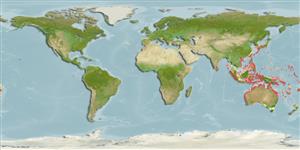Emydocephalus annulatus Krefft, 1869
Turtle-headed seasnake| Native range | All suitable habitat | Point map | Year 2050 |

|
| This map was computer-generated and has not yet been reviewed. |
| Emydocephalus annulatus AquaMaps Data sources: GBIF OBIS |
Hochladen Photos
Google Bild |
No photo available for this species.No drawings available for Hydrophiidae.
Google Bild |
No photo available for this species.
Classification / Names Common names | Synonyms | CoL | ITIS | WoRMS
| Squamata | Hydrophiidae
Environment: milieu / climate zone / depth range / distribution range Ökologie
Riff-verbunden; tiefenbereich 1 - 15 m (Ref. 78637). Tropical; 51°N - 58°S (Ref. 356)
Verbreitung Länder | FAO Gebiete | Ecosystems | Vorkommen | Einführungen
Indo-West Pacific, Northwest Atlantic and the Mediterranean.
Length at first maturity / Size / Gewicht / Alter
Maturity: Lm ?, range 880 - ? cm Max length : 91.0 cm SVL Männchen/unbestimmt; (Ref. 78637); common length : 90.0 cm SVL Männchen/unbestimmt; (Ref. 2352)
Feeds exclusively and frequently on large numbers of eggs of small fishes such as damselfish, blennies and gobies. Moves slowly and continuously across crevices and burrows while hunting for fish nests. Only active during daylight. Locates its prey via smell rather than through visual cues (Ref. 101738).
Life cycle and mating behavior Geschlechtsreife | Fortpflanzung | Ablaichen | Eier | Fecundity | Larven
Mating behavior: Males stimulate females during copulation with the use of their larger rostral spine.
Hauptreferenz
Referenzen | Koordinator | Partner
SAUP Database. 2006. (Ref. 356)
IUCN Rote Liste Status (Ref. 130435)
nicht bedroht (LC) ; Date assessed: 15 February 2009
CITES Status (Ref. 108899)
Not Evaluated
CMS (Ref. 116361)
Not Evaluated
Bedrohung für Menschen
Nutzung durch Menschen
| FishSource |
Tools
Mehr Information
Internet Quellen
BHL | BOLD Systems | CISTI | DiscoverLife | FAO(Publication : search) | Fishipedia | GenBank (Genom, nucleotide) | GloBI | Gomexsi | Google Books | Google Scholar | Google | PubMed | Tree of Life | Wikipedia (Gehe zu, Suchen) | Zoological Record
Estimates based on models
Preferred temperature
(Ref. 115969): 17.6 - 29.3, mean 28.1 (based on 2331 cells).
Preiskategorie
(Ref. 80766):
Unknown.


